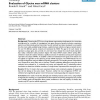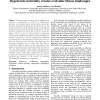31 search results - page 3 / 7 » Redundant genes and the evolution of robustness |
BMCBI
2005
13 years 5 months ago
2005
Background: Clustering the ESTs from a large dataset representing a single species is a convenient starting point for a number of investigations into gene discovery, genome evolut...
GEM
2009
13 years 3 months ago
2009
- Understanding how systems can be designed to be evolvable is fundamental to research in optimization, evolution, and complex systems science. Many researchers have thus recognize...
BMCBI
2010
13 years 6 months ago
2010
Background: The evolution of high throughput technologies that measure gene expression levels has created a data base for inferring GRNs (a process also known as reverse engineeri...
BMCBI
2008
13 years 6 months ago
2008
Background: Detecting conserved noncoding sequences (CNSs) across species highlights the functional elements. Alignment procedures combined with computational prediction of transc...
IANDC
2011
13 years 29 days ago
2011
Abstract. Gene trees are leaf-labeled trees inferred from molecular sequences. Due to duplication events arising in genome evolution, gene trees usually have multiple copies of som...


